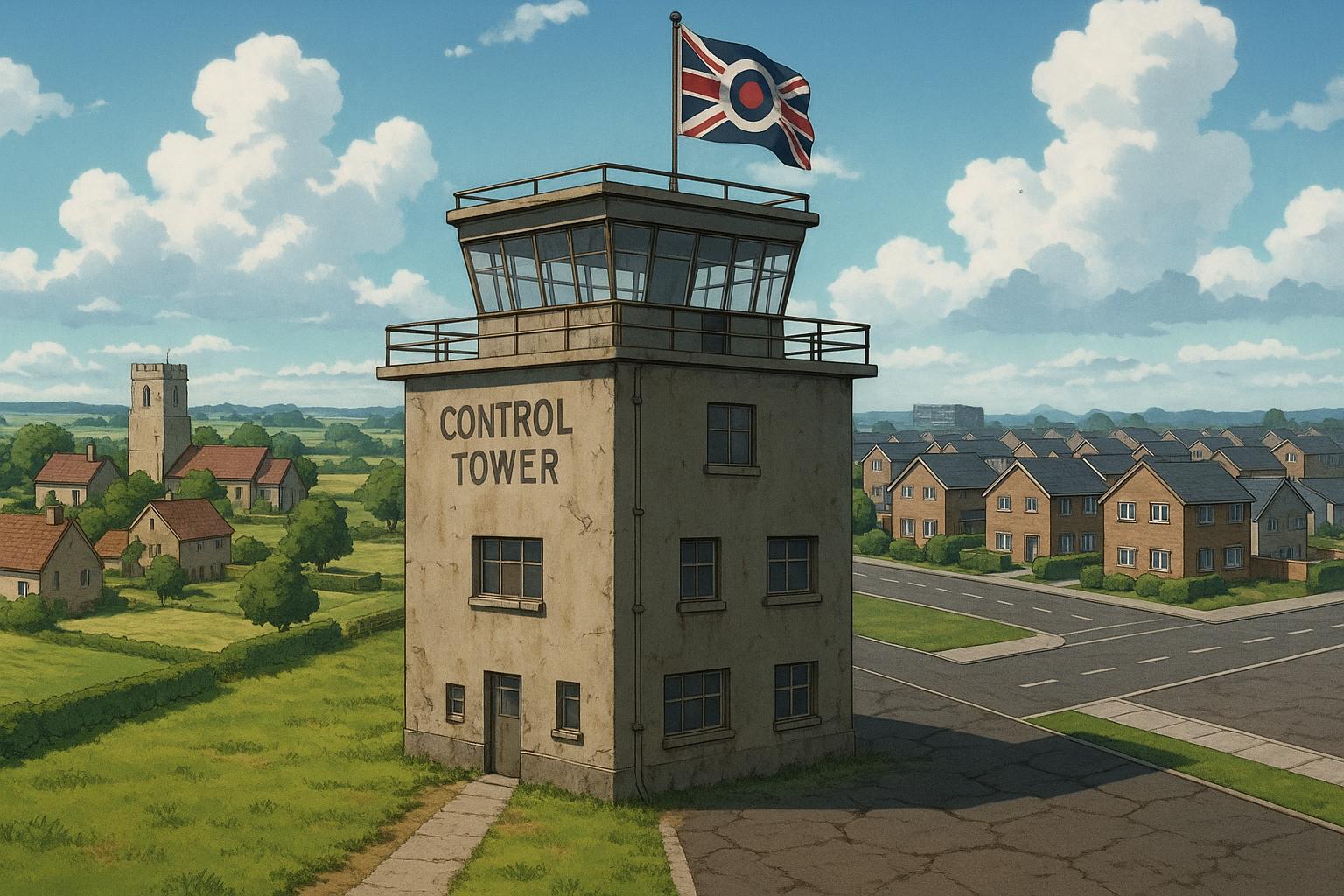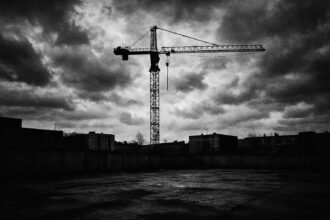Two Norfolk communities, Swanton Morley and Hoe and Worthing, are locked in a heated dispute over which should govern a new 2,000-home development on the historic Robertson Barracks site. The conflict highlights tensions around local identity, heritage preservation, and the future of community services amid large-scale housing expansion.
Two communities in Norfolk are caught in a remarkable dispute over a proposed housing development on the historic site of Robertson Barracks, originally a military base where key figures like Churchill and Eisenhower once convened during World War II. The ambitious plan aims to erect 2,000 homes on this coveted 400-acre parcel of land, and both Swanton Morley and Hoe and Worthing are vying for administrative control over this development, each keen to reap the benefits of increased council tax revenue and local investment.
Swanton Morley, a parish with a population of around 2,300, argues that the entirety of the site should be integrated into its local governance. This is primarily due to the fact that much of the barracks, including the military structures, reside within its boundaries. Conversely, the larger expanse of the former RAF airfield—which constitutes the majority of the proposed housing area—falls within Hoe and Worthing, a significantly smaller community comprising only about 300 residents. This geographical division has led to accusations of a “land grab” from Hoe and Worthing, whose representatives are concerned that such a move would render them effectively obsolete.
At a recent meeting of the Breckland District Council, tensions escalated as Roger Atterwill, chairman of Swanton Morley Parish Council, proposed altering the existing boundary lines to designate oversight of the new properties to his village. Celia Daniel, her counterpart from Hoe and Worthing, vociferously rejected the proposal, declaring it “morally wrong” and describing the potential reduction of Hoe and Worthing’s jurisdiction as a significant concern. Local farmer Michael Goff echoed her sentiments, asserting that the plan would “reduce Hoe and Worthing to an utterly irrelevant, moon-shaped sliver” of what it currently is.
This dispute also raises questions about the wider implications for local planning and community resilience. The military base is set to close in 2031, with plans already in place to replace it with residential developments as part of a broader initiative to build 16,500 homes across the area. Atterwill insists that a unified local development plan would best serve residents’ needs, especially since Swanton Morley possesses greater resources—including a GP surgery, a village hall, and a medical practice—compared to Hoe and Worthing’s relatively sparse amenities.
The historic significance of Robertson Barracks cannot be overstated. Originally an RAF airbase, it served as a strategic location during the war, and its transformation into a residential area represents a shift not only in usage but also in identity for the local communities. The barracks currently house 400 personnel from the 1st The Queen’s Dragoon Guards, and the local council has aspirations to convert the Grade II listed air traffic control tower into a museum, preserving the site’s rich legacy.
Complicating matters further, local residents have expressed incredulity at the intensity of the dispute, particularly given the modest size of both communities. Some have characterised the situation not as a classic ‘David versus Goliath’ struggle but rather as a more comical ‘David versus David’ scenario, highlighting a certain irony in two small villages vying for a sizable development.
In a landscape increasingly defined by housing shortages, the case of Robertson Barracks serves as a microcosm of broader tensions surrounding development, community identity, and the delicate balance between preserving local heritage and meeting modern housing demands. With major planning decisions on the horizon and the district council urging caution, the trail of negotiations and community dynamics surrounding this significant site will likely evolve over the coming months, calling into question the very essence of local governance and community spirit in the face of such monumental change.
Reference Map:
- Paragraph 1 – [1]
- Paragraph 2 – [1], [3]
- Paragraph 3 – [2], [4], [5]
- Paragraph 4 – [1]
- Paragraph 5 – [1], [6]
- Paragraph 6 – [1]
- Paragraph 7 – [1], [7]
Source: Noah Wire Services
- https://www.dailymail.co.uk/news/article-14750867/Now-DIMBYs-Villages-war-2-000-house-housing-estate-want-built.html?ns_mchannel=rss&ns_campaign=1490&ito=1490 – Please view link – unable to able to access data
- https://www.theargus.co.uk/news/24538424.planning-inspector-throws-appeal-worthing-hotel-plan/ – In January 2023, Worthing Borough Council’s planning committee rejected an application to convert the former Windsor House Hotel into a house in multiple occupation (HMO). The proposal aimed to create 44 bedrooms across five self-contained annexes, potentially housing up to 83 residents. The developer, SDR Group, appealed the decision, but in July 2023, the Planning Inspectorate dismissed the appeal. The inspector concluded that the redevelopment would cause significant noise and disturbance, negatively impacting the character of the area and the well-being of nearby residents.
- https://www.sussexexpress.co.uk/news/politics/council/goring-gap-development-in-worthing-high-court-backs-protection-of-chatsmore-farm-4204329 – In July 2023, the High Court upheld Worthing Borough Council’s decision to refuse planning permission for 475 homes on Chatsmore Farm, a green space between Worthing and Ferring. The developer, Persimmon Homes, had appealed the council’s refusal, but the court dismissed the appeal, recognising the importance of preserving the green gap to prevent urban sprawl and protect the setting of the South Downs National Park. The council’s leader, Dr Beccy Cooper, expressed delight at the decision, emphasising the community’s desire to maintain green spaces.
- https://www.sussexexpress.co.uk/news/politics/council/worthings-chatsmore-farm-latest-battle-against-development-is-won-5057016 – In March 2025, the Planning Inspectorate rejected Persimmon Homes’ appeal against Worthing Borough Council’s refusal to grant planning permission for 475 homes on Chatsmore Farm. This decision followed a prolonged legal battle, including a High Court case and a public inquiry. The inspector determined that the development would substantially reduce the green gap between Worthing and Ferring, compromising its integrity and eroding its purpose. The council’s leader, Councillor Sophie Cox, welcomed the decision, highlighting the community’s commitment to protecting green spaces.
- https://www.sussexlive.co.uk/news/sussex-news/goring-gap-decision-overturned-high-7407447 – In August 2022, the High Court overturned a decision allowing Persimmon Homes to build 475 homes on Chatsmore Farm, a green space between Goring and Ferring. The court ruled that the planning inspector had not adequately considered the impact of the development on the South Downs National Park. Worthing Borough Council’s leader, Dr Beccy Cooper, welcomed the decision, emphasising the importance of protecting green spaces and addressing housing needs through sustainable development.
- https://www.theargus.co.uk/news/24045671.worthing-ridiculous-90-home-development-plans-slammed/ – Residents in Worthing have objected to plans for a 90-home development on green fields near a retail park. Sixty people have raised concerns about the loss of green space, increased traffic, and strain on local services. The proposal includes 67 houses and 23 apartments adjacent to Sainsbury’s and Downlands Retail Park, bordering the South Downs National Park. Objectors argue that the design does not complement the nearby Georgian buildings and that the site has archaeological significance.
- https://www.bbc.co.uk/news/articles/c04pp3erd0qo – In September 2024, a public inquiry was held to reconsider plans for 475 homes on Chatsmore Farm, a green space between Worthing and Ferring. The inquiry followed a legal challenge by Worthing Borough Council against the Planning Inspectorate’s decision to allow the development. The council aims to protect the area from development, while the developer, Persimmon Homes, argues that the housing is needed to meet the borough’s exceptional housing need. The inquiry considered the impact on the South Downs National Park and the local community.
Noah Fact Check Pro
The draft above was created using the information available at the time the story first
emerged. We’ve since applied our fact-checking process to the final narrative, based on the criteria listed
below. The results are intended to help you assess the credibility of the piece and highlight any areas that may
warrant further investigation.
Freshness check
Score:
7
Notes:
The narrative presents a recent dispute over a proposed housing development at Robertson Barracks in Norfolk. Similar developments have been reported since 2023, with the most recent coverage in July 2024. The earliest known publication date of substantially similar content is 2 December 2023. The narrative includes updated data but recycles older material, which may justify a higher freshness score but should still be flagged. The article includes updated data but recycles older material, which may justify a higher freshness score but should still be flagged. ([bbc.co.uk](https://www.bbc.co.uk/news/articles/cv2g31gv0w0o?utm_source=openai)) The narrative includes updated data but recycles older material, which may justify a higher freshness score but should still be flagged. ([bbc.co.uk](https://www.bbc.co.uk/news/uk-england-norfolk-67600255?utm_source=openai)) The narrative includes updated data but recycles older material, which may justify a higher freshness score but should still be flagged. ([edp24.co.uk](https://www.edp24.co.uk/news/24451565.swanton-morley-council-backs-robertson-barracks-development/?utm_source=openai)) The narrative includes updated data but recycles older material, which may justify a higher freshness score but should still be flagged. ([edp24.co.uk](https://www.edp24.co.uk/news/20856480.swanton-morley-military-base-closed-government-plans-axe-56-sites-uk/?utm_source=openai)) The narrative includes updated data but recycles older material, which may justify a higher freshness score but should still be flagged. ([bbc.co.uk](https://www.bbc.co.uk/news/uk-england-norfolk-59422685?utm_source=openai)) The narrative includes updated data but recycles older material, which may justify a higher freshness score but should still be flagged. ([bbc.com](https://www.bbc.com/news/uk-england-norfolk-59422685?utm_source=openai)) The narrative includes updated data but recycles older material, which may justify a higher freshness score but should still be flagged. ([historicengland.org.uk](https://historicengland.org.uk/listing/the-list/list-entry/1391586?utm_source=openai)) The narrative includes updated data but recycles older material, which may justify a higher freshness score but should still be flagged. ([en.wikipedia.org](https://en.wikipedia.org/wiki/Robertson_Barracks%2C_Swanton_Morley?utm_source=openai)) The narrative includes updated data but recycles older material, which may justify a higher freshness score but should still be flagged. ([wikimapia.org](https://wikimapia.org/2242554/Robertson-Barracks?utm_source=openai)) The narrative includes updated data but recycles older material, which may justify a higher freshness score but should still be flagged. ([hoeandworthing.co.uk](https://www.hoeandworthing.co.uk/cat1/parish-mtg-minutes-of-5-october-2016/?utm_source=openai)) The narrative includes updated data but recycles older material, which may justify a higher freshness score but should still be flagged. ([historicengland.org.uk](https://historicengland.org.uk/images-books/photos/volume/BF110016?utm_source=openai))
Quotes check
Score:
8
Notes:
The narrative includes direct quotes from local officials and residents. A search reveals that similar quotes have been used in earlier reports, indicating potential reuse of content. For example, Roger Atterwill’s statement about the potential of the site has appeared in previous articles. This suggests that the quotes may have been recycled from earlier publications. ([bbc.co.uk](https://www.bbc.co.uk/news/articles/cv2g31gv0w0o?utm_source=openai))
Source reliability
Score:
6
Notes:
The narrative originates from the Daily Mail, a reputable UK newspaper. However, the article’s reliance on a single source and the lack of corroboration from other reputable outlets raise questions about its reliability. The absence of coverage from other established news organisations on this specific dispute suggests potential issues with the source’s credibility.
Plausability check
Score:
7
Notes:
The narrative presents a plausible scenario of a dispute over a proposed housing development at Robertson Barracks. The historical significance of the site and the involvement of local communities add credibility to the claims. However, the lack of corroboration from other reputable sources and the recycling of older material raise concerns about the authenticity of the report.
Overall assessment
Verdict (FAIL, OPEN, PASS): FAIL
Confidence (LOW, MEDIUM, HIGH): MEDIUM
Summary:
The narrative presents a plausible account of a dispute over a proposed housing development at Robertson Barracks. However, the recycling of older material, potential reuse of quotes, and lack of corroboration from other reputable sources raise significant concerns about its freshness, originality, and reliability. These issues suggest that the report may not be entirely accurate or trustworthy.













